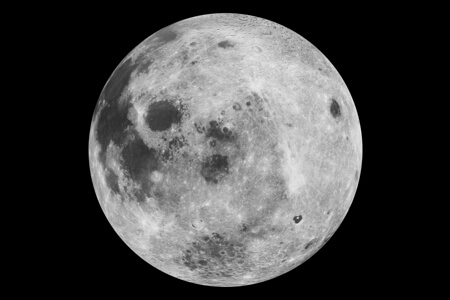The Moon

The Moon travels around Earth in an oval orbit at 36,800 kilometers per hour. The Moon does not have an atmosphere, so temperatures range from -184 degrees Celsius during its night to 214 degrees Celsius during its day except at the poles where the temperature is a constant -96 degrees Celsius.
 |
The Moon is actually a little lopsided due to the lunar crust being thicker on one side than the other. When you look at the Moon, you will see dark and light areas. The dark areas are young plains called maria and are composed of basalt. The basalt flowed in and flooded the area created by a huge impact with an asteroid or comet. The light areas are the highlands, which are mountains that were uplifted as a result of impacts. The lunar surface is covered by a fine-grained soil called “regolith” which results from the constant bombardment of the lunar rocks by small meteorites.
Scientists theorize that the Moon was the result of a collision between Earth and an object the size of Mars. One theory states that the debris from the impact was hurtled into space where, due to gravity, it combined. This resulted in the formation of the Moon.
The gravitational pull of the Moon on the Earth affects the ocean tides on Earth. The closer the Moon is to Earth, the greater the effect. The time between high tides is about 12 hours and 25 minutes.
TERMS TO KNOW
ASTEROID A rocky space object that can be from a few hundred feet to several hundred km wide.
ATMOSPHERE The layers of gases that surround a star, like our Sun, or a planet, like our Earth.
BASALT A dark, fine-grained volcanic rock.
COMET Frozen masses of gas and dust which have a definite orbit through the solar system.
GRAVITY The force of attraction between two objects which is influenced by the mass of the two objects and the distance between the two objects.
ORBIT A specific path followed by a planet, satellite, etc. PLAINS Vast, flat areas with low elevation.
